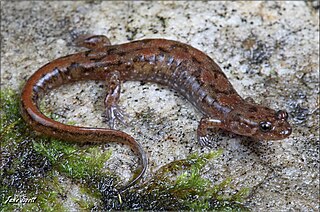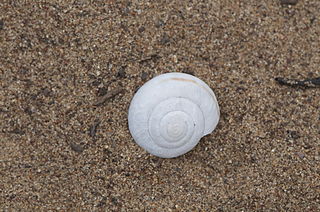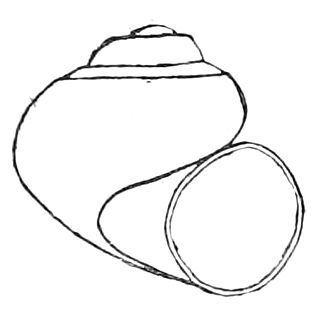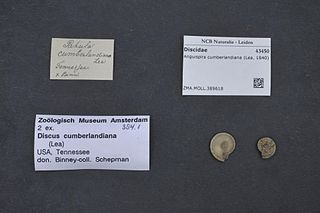Alasmidonta atropurpurea, common name Cumberland elktoe, is a species of freshwater mussel, an aquatic bivalve mollusk in the family Unionidae, the river mussels.

Anguispira, the tigersnails, is a genus of small pulmonate land snails in the family Discidae endemic to North America. Snails in this genus are defined by their striped shells. Anguispira species are either habitat generalists like A. alternata or limestone specialists like A. cumberlandiana.

The Cumberland dusky salamander is a species of salamander in the family of lungless salamanders, Plethodontidae. It is endemic to the United States. Its natural habitats are temperate forests and rivers. This species is threatened by habitat loss.

Iwasaki's snail-eater is a species of snake in the family Pareidae. The species is endemic to the Yaeyama Islands in the southern Ryukyu Islands, Japan.

Achatinella abbreviata, an Oʻahu tree snail, is an extinct species of colorful tropical tree-living air-breathing land snail, an arboreal pulmonate gastropod mollusk in the genus Achatinella.

Achatinella livida is a critically endangered species of air-breathing land snail in the family Achatinellidae. This species is endemic to Oʻahu, Hawaiʻi.
Beddomeia protuberata is a species of endemic freshwater snail in the family Tateidae, found in northern Tasmania, Australia. The shells look ovate and periostracum yellow with some pustules, length between 2.29 mm and 2.93 mm and width between 2.01 mm and 2.34 mm. Beddomeia protuberata has 1.75 protoconch whorls. Its image of microsculpture is uniform and its wrinkles arranged weakly and helically. The teleoconch of beddomeia protuberata has 2.2 to 2.7 convex whorls, and the ratio of convexity is 0.15 to 0.24. Sculptures of the teleoconch are vague with prosocline growth lines. The margin of the last whorl is evenly circular. The thickness and width of inner lips are medium sizes, and the columellar swelled up prominently. The outer lips of Beddomeia protuberata is prosocline, which means the shell leans forwards compared to the shell’s coiling axis. The width of their umbilicus is between 0.31 mm to 0.51 mm. The umbilicus of female beddomeia protuberata are wider than the umbilicus of male.

The banded dune snail or Morro shoulderband(Helminthoglypta walkeriana) is a species of endangered air-breathing land snail, a terrestrial pulmonate gastropod mollusc in the subfamily Helminthoglyptinae.

Plethobasus cooperianus, the orange-footed pimpleback mussel or orangefoot pimpleback, is a rare species of freshwater mussel in the family Unionidae, the river mussels. This aquatic bivalve mollusk is native to the Tennessee, Cumberland, and lower Ohio Rivers in the United States, where its distribution has declined over 70%.
The armored marstonia, scientific name Marstonia pachyta, also known as Pyrgulopsis pachyta, is a species of freshwater snail, an aquatic gastropod mollusc in the family Hydrobiidae.
The flat-spired three-toothed snail —also known as the Cheat three-toothed snail after the Cheat River in West Virginia—is a species of air-breathing land snail, a terrestrial pulmonate gastropod mollusk in the family Polygyridae.

The Utah roundmouth snail, also known as the Utah valvata or desert valvata, scientific name Valvata utahensis, is a species of freshwater snail with a gill and an operculum, an aquatic gastropod mollusc in the family Valvatidae, the valve snails.

Patera clarki nantahala, the noonday globe, is a subspecies of Patera clarki, a land snail in the family Polygyridae. It is endemic to North Carolina in the United States.
Opisthostoma vermiculum is a species of minute land snail with an operculum, a terrestrial gastropod mollusk or micromollusk in the family Diplommatinidae. The shell possesses four different coiling axes; the most for any known living gastropod. This member of the Diplommatinidae family is endemic to Malaysia. Its natural habitat is tropical limestone outcrops.

Anguispira cumberlandiana, the Cumberland tigersnail or the Cumberland disc, is a range-restricted species of land snail; a terrestrial pulmonate gastropod mollusc in the family Discidae. They possess a lens shaped shell with convex whorls and a pinched, serrated keel. The shell is typically pale olive or tan in color, with radiating chestnut stripes and oblique radial streaks. This species is found in a few counties in Alabama and Tennessee along the Cumberland Plateau in the United States.

The palezone shiner is a rare species of ray-finned fish in the family Cyprinidae. It is native to Alabama and Kentucky in the United States. It once occurred in Tennessee, but it has been extirpated from the state. There are two populations remaining. It is a federally listed endangered species of the United States.

Sherwood is an unincorporated community in Franklin County, Tennessee, United States. It is located along Tennessee State Route 56 13.1 miles (21.1 km) southeast of Winchester, and just north of the Alabama state line. Sherwood has a post office with ZIP code 37376.
The Land Trust for Tennessee is a non-profit conservation organization working to protect Tennessee's natural, scenic, and historic landscapes and sites. Since 1999, The Land Trust has conserved more than 135,000 acres (550 km2) of land across 65-plus Tennessee counties.

Anguispira kochi, the banded tigersnail, is a species of pulmonate terrestrial gastropod belonging to the family Discidae, the disk snails. There are two recognized subspecies: Anguispira kochi kochi or the eastern banded tigersnail, and Anguispira kochi occidentalis, the western banded tigersnail.
Anguispira alabama, also known as the Alabama tigersnail or Alabama disc, is a rare, range-restricted species of pulmonate land snail found in Alabama and Tennessee. Due to its rarity and the difficulty of locating new populations, the species is listed as vulnerable in both states.
















